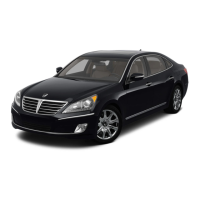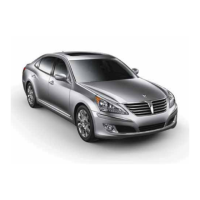Do you have a question about the Hyundai Equus 2015 and is the answer not in the manual?
Guidance on utilizing the owner's manual and its sections for vehicle information and safety.
Recommendations for the first 600 miles to ensure optimal performance, economy, and longevity.
Identification of exterior components of the vehicle from the front view.
Identification of exterior components of the vehicle from the rear view.
Identification of interior components and controls within the vehicle.
Identification of the instrument panel features and controls.
Identification of major components located in the engine compartment.
Details on adjusting driver, front passenger, and rear seats for comfort and safety.
Information on seat belt restraint system, proper usage, and precautions.
Guidelines for safely installing and using child restraint systems in the vehicle.
Explanation of SRS components, functions, and operation of the air bag system.
Operation and precautions for the smart key system, including locking, unlocking, and panic functions.
Instructions for operating door locks from outside and inside the vehicle.
Operation of the non-powered and power trunk, including safety precautions.
Operation of power windows, including auto up/down and reverse features.
Instructions for opening and closing the vehicle's hood, including safety warnings.
Procedure for opening and closing the fuel filler lid, with safety precautions.
Operation of the sunroof, including sliding, tilting, and automatic reverse features.
Storing and recalling driver seat, mirror, steering wheel, and HUD positions.
Information on electronic hydraulic power steering and tilt/telescopic steering adjustments.
Details on interior and exterior rearview mirrors, including auto-dimming and HomeLink.
Overview of the instrument cluster, including gauges and LCD display.
Explanation of the speedometer, tachometer, and coolant temperature gauges.
Indication of the approximate fuel remaining in the tank and related warnings.
Indicates total vehicle distance driven for maintenance scheduling.
Explanation of different display modes like Trip Computer, ASCC/LDWS, and A/V.
Pre-drive checks including windows, mirrors, lights, gauges, and brake system.
Operation of the illuminated engine start/stop button in various positions.
Operation of the 8-speed automatic transmission and shift lever positions.
Information on power brakes, EPB, ABS, ESC, HAC, and braking practices.
Selection and operation of drive modes like NORMAL, SPORT, and SNOW.
Functionality, settings, and limitations of the smart cruise control system.
Operation and warnings for the system that detects lane departure.
Information on using hazard warning flashers for emergency repairs or roadside stops.
Procedures for engine stalls, flat tires, and starting issues.
Troubleshooting steps for when the engine does not turn over or start.
Instructions for jump starting a vehicle using jumper cables safely.
Information on TPMS operation, malfunction indicators, and tire pressure checks.
Steps for changing a tire, including jack usage and tool locations.
Guidelines for towing services and emergency towing procedures.
Identification of components in the engine compartment for inspection and maintenance.
Overview of maintenance services and owner responsibilities.
Owner's role in maintenance records and compliance with warranty requirements.
General guidelines and checks for owner maintenance of the vehicle.
Normal and severe usage maintenance schedules and intervals.
Procedures for checking and changing engine oil and filter.
Checking coolant level, recommended coolant, and changing coolant procedures.
Tips for best battery service, including dangers and recharging procedures.
Information on tire care, recommended pressures, rotation, and replacement.
Key vehicle dimensions including length, width, height, and wheelbase.
Specifications for various light bulb wattages and types used in the vehicle.
Details on tire specifications, inflation pressures, and wheel lug nut torque.
Recommended lubricants and fluids for engine, transmission, and other systems.
Location and purpose of the vehicle identification number (VIN).
Contact information for Hyundai Motor America regional offices for assistance.
Procedure for reporting vehicle defects to NHTSA and Hyundai Motor America.
Guidance on utilizing the owner's manual and its sections for vehicle information and safety.
Recommendations for the first 600 miles to ensure optimal performance, economy, and longevity.
Identification of exterior components of the vehicle from the front view.
Identification of exterior components of the vehicle from the rear view.
Identification of interior components and controls within the vehicle.
Identification of the instrument panel features and controls.
Identification of major components located in the engine compartment.
Details on adjusting driver, front passenger, and rear seats for comfort and safety.
Information on seat belt restraint system, proper usage, and precautions.
Guidelines for safely installing and using child restraint systems in the vehicle.
Explanation of SRS components, functions, and operation of the air bag system.
Operation and precautions for the smart key system, including locking, unlocking, and panic functions.
Instructions for operating door locks from outside and inside the vehicle.
Operation of the non-powered and power trunk, including safety precautions.
Operation of power windows, including auto up/down and reverse features.
Instructions for opening and closing the vehicle's hood, including safety warnings.
Procedure for opening and closing the fuel filler lid, with safety precautions.
Operation of the sunroof, including sliding, tilting, and automatic reverse features.
Storing and recalling driver seat, mirror, steering wheel, and HUD positions.
Information on electronic hydraulic power steering and tilt/telescopic steering adjustments.
Details on interior and exterior rearview mirrors, including auto-dimming and HomeLink.
Overview of the instrument cluster, including gauges and LCD display.
Explanation of the speedometer, tachometer, and coolant temperature gauges.
Indication of the approximate fuel remaining in the tank and related warnings.
Indicates total vehicle distance driven for maintenance scheduling.
Explanation of different display modes like Trip Computer, ASCC/LDWS, and A/V.
Pre-drive checks including windows, mirrors, lights, gauges, and brake system.
Operation of the illuminated engine start/stop button in various positions.
Operation of the 8-speed automatic transmission and shift lever positions.
Information on power brakes, EPB, ABS, ESC, HAC, and braking practices.
Selection and operation of drive modes like NORMAL, SPORT, and SNOW.
Functionality, settings, and limitations of the smart cruise control system.
Operation and warnings for the system that detects lane departure.
Information on using hazard warning flashers for emergency repairs or roadside stops.
Procedures for engine stalls, flat tires, and starting issues.
Troubleshooting steps for when the engine does not turn over or start.
Instructions for jump starting a vehicle using jumper cables safely.
Information on TPMS operation, malfunction indicators, and tire pressure checks.
Steps for changing a tire, including jack usage and tool locations.
Guidelines for towing services and emergency towing procedures.
Identification of components in the engine compartment for inspection and maintenance.
Overview of maintenance services and owner responsibilities.
Owner's role in maintenance records and compliance with warranty requirements.
General guidelines and checks for owner maintenance of the vehicle.
Normal and severe usage maintenance schedules and intervals.
Procedures for checking and changing engine oil and filter.
Checking coolant level, recommended coolant, and changing coolant procedures.
Tips for best battery service, including dangers and recharging procedures.
Information on tire care, recommended pressures, rotation, and replacement.
Key vehicle dimensions including length, width, height, and wheelbase.
Specifications for various light bulb wattages and types used in the vehicle.
Details on tire specifications, inflation pressures, and wheel lug nut torque.
Recommended lubricants and fluids for engine, transmission, and other systems.
Location and purpose of the vehicle identification number (VIN).
Contact information for Hyundai Motor America regional offices for assistance.
Procedure for reporting vehicle defects to NHTSA and Hyundai Motor America.
| Brand | Hyundai |
|---|---|
| Model | Equus 2015 |
| Category | Automobile |
| Language | English |












